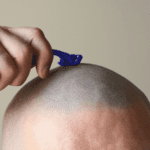Introduction: The Classic Debate in Wet Shaving
“Shaving Soap vs Cream” is a timeless comparison that has fueled countless discussions among wet shaving enthusiasts, barbers, and grooming experts alike. As men rediscover the charm of traditional grooming and search for better skin experiences, this debate continues to resurface—which one offers a smoother shave, richer lather, better scent, or longer-lasting performance? This comprehensive guide unpacks every layer of the argument to help you decide which product best suits your routine, your skin, and your sense of style.
Why Choosing the Right Lathering Product Matters
The product you choose to build your lather can dramatically influence not only the quality of your shave but also your overall skincare. A great lather cushions the skin, softens the beard, and provides essential glide, while a poor one may cause tugging, razor burn, or dry skin. Whether you choose shaving soap or cream, your face will feel the difference.
Understanding the Basics: What Is Shaving Soap?
Shaving soap is a traditional grooming product that typically comes in a solid puck or bar form. It requires a brush and water to create a rich, stable lather. Shaving soaps are known for their longevity, luxurious textures, and minimalist ingredients—often ideal for sensitive skin or for those who enjoy the ritual of shaving.
Understanding the Basics: What Is Shaving Cream?
Shaving cream is a softer, creamier alternative that often comes in a tube, tub, or can. It’s typically easier and faster to lather, requiring less work to achieve a thick foam. Shaving creams are popular for their convenience, hydrating formulas, and wide range of available scents.
A Brief History of Shaving Soap and Cream
Shaving soap has been around since the 1800s, once the hallmark of old-school barbershops and Victorian-era vanities. Shaving cream came later in the 20th century, gaining popularity during wartime for its portability and ease of use. Both have evolved to serve distinct needs in the modern grooming landscape.
Texture and Consistency: The Key Physical Differences
Shaving soap is hard, dense, and requires moisture to soften before use, while shaving cream is soft, airy, and often pre-whipped. The texture influences how each product is loaded onto the brush and ultimately how it performs on the skin.
Scent Profiles: Subtle Aromas vs Bold Fragrances
Soaps often carry subtler, more natural fragrances derived from essential oils, while creams can be more fragrant and expressive, often using synthetic or more complex aromatic blends. Your choice may come down to whether you prefer understated elegance or a more bold aromatic experience.
Lathering Methods Compared: Soap vs Cream
Lathering a soap typically involves swirling a damp brush over the puck and then transferring to a bowl or face. Creams can be scooped directly into a bowl or even applied straight to the brush. While both can produce luxurious foam, soaps require a bit more technique and patience.
Tools Required for Each Product
For shaving soap, you’ll need a brush, bowl, and often a puck holder or container. Creams can sometimes be used without a bowl, but still benefit from a quality brush. Boar, badger, and synthetic brushes all work differently with each product, influencing water retention and lathering ability.
Time Required to Create Quality Lather
Soap generally takes longer to lather, often a full minute or more of swirling and whipping. Cream lathers much faster, making it a favorite for rushed mornings or travel scenarios. But many find the time invested in soap lathering to be part of the joy.
Beginner-Friendliness: Which Is Easier to Use?
Creams are more intuitive and forgiving for beginners, while soaps may take a few tries to master. The learning curve for soaps pays off with a richer, longer-lasting lather once perfected.
Packaging Differences: Eco-Friendly vs Convenient
Shaving soaps often come in reusable or recyclable tins, pucks, or paper wrappings—making them an eco-friendly choice. Shaving creams, particularly those in aerosol cans, contribute more to landfill waste. For environmentally conscious consumers, soap often wins this round.
Shaving Soap: The Pros That Win Over Traditionalists
Soap offers a nostalgic, tactile experience, unbeatable value per use, and a customizable lather tailored to your exact water-to-soap ratio. Its minimal ingredients are gentler on sensitive skin, and its longevity means months of use from a single puck.
Shaving Cream: The Benefits That Appeal to Modern Shavers
Creams are fast, hydrating, and widely available. They’re perfect for those who want a quality shave without the extra steps. Many creams also come fortified with aloe, glycerin, or essential oils for enhanced skincare.
Skin Types and Reactions: Which Is Better for Sensitive Skin?
Shaving soap, especially unscented or all-natural versions, is often favored by those with sensitive skin due to fewer chemicals and preservatives. That said, many creams are now formulated for sensitive skin and may offer extra moisturization.
Moisturization Properties: Which Keeps Your Skin Softer?
Shaving creams often include hydrating agents like lanolin, coconut oil, or aloe vera that leave the skin feeling nourished. Soaps offer a clean post-shave feel but may require a separate balm for moisturization.
Lather Longevity: Which One Lasts Through Multiple Passes?
A well-built soap lather tends to be more stable and consistent, holding up through multiple razor passes without breaking down. Creams can occasionally dissipate faster, especially under warm or humid conditions.
Cost-Effectiveness Over Time
One puck of soap can last for several months, making it incredibly cost-effective. Creams, depending on usage and packaging size, may run out faster, especially with daily use. Soap often wins on long-term value.
Which Offers a Closer Shave?
While technique matters more than lather, many users report that the dense cushion of shaving soap offers slightly more control and blade contact. Creams can deliver excellent shaves too, especially when paired with high-quality razors.
Which Provides Better Cushion and Glide?
Soaps are known for superior cushion and blade protection. Creams, with their smooth textures and added moisturizers, often offer enhanced glide. Ultimately, cushion is where soap excels, while glide may lean in favor of cream.
Shelf Life and Storage: Which One Lasts Longer?
Shaving soap has a near-indefinite shelf life if stored properly, often improving with age like a fine wine. Creams, especially those with added oils or water content, may spoil or lose consistency after 12–24 months.
Availability and Variety in the Market
Creams are widely available at supermarkets, drugstores, and online, with a broad range of brands and scents. Shaving soaps, while slightly more niche, are booming in artisanal markets and specialty shops.
Performance in Humid or Dry Climates
Soaps tend to perform better in dry environments, retaining consistency longer. Creams may melt or separate in high heat but can be more comfortable in cold, dry weather due to their moisturizing properties.
Travel Friendliness: Portability and TSA Considerations
Soaps in puck form are dry and easy to travel with, avoiding TSA liquid restrictions. Creams, especially in aerosol or tubes, may be subject to travel limitations.
Mess Factor: Which Is Easier to Clean Up?
Soaps, when used properly, leave less residue and are easier to rinse. Creams can be messier, especially if over-applied or left on the razor between passes.
User Experience: Ritualistic vs Quick and Easy
Soap provides a slower, more meditative ritual—perfect for those who enjoy shaving as a craft. Cream is ideal for those who want a clean shave with minimal effort or time.
Best Use Cases for Shaving Soap
- Traditional wet shavers
- Sensitive or allergy-prone skin
- Long-term value seekers
- Zero-waste advocates
Best Use Cases for Shaving Cream
- Beginners
- Travelers
- Time-conscious users
- Those who prefer luxurious scents and hydration
Is One Better for Beard Types or Lengths?
Soaps work best on coarse or thick beards due to their rich cushion. Creams excel on lighter or shorter facial hair, where glide is more important than density.
How Do Barbers Weigh In?
Barbers often prefer shaving soap for its durability and control, especially in straight razor shaves. However, many use creams for speed, scent variety, and skin conditioning benefits during high-volume appointments.
Using Both: Can You Mix Shaving Soap and Cream?
Absolutely. This is known as “superlather.” Combining soap and cream gives you the cushion of soap with the glide and scent of cream—a best-of-both-worlds option for advanced users.
Top-Rated Shaving Soaps Worth Trying
- Proraso Shaving Soap
- Mitchell’s Wool Fat
- Stirling Soap Co.
- Tabac Original
Top-Rated Shaving Creams You Should Know
- Taylor of Old Bond Street
- The Art of Shaving
- Cremo Original
- Nivea Men Sensitive
- learn more about How to use Shaving Soap
Tips for Transitioning from Cream to Soap
- Use a synthetic brush to ease loading
- Practice lathering in a bowl
- Start with soft soaps (croaps) before moving to hard pucks
Tips for Enhancing Your Lather Regardless of Choice
- Use warm, not hot water
- Pre-soak your brush
- Add water gradually to avoid breaking the lather
Does Brush Type Matter More with Soap or Cream?
Yes. Soap requires a brush with good backbone to pick up product, while cream works well with soft or synthetic brushes. Choosing the right brush improves results for both.
Can Either Be Used Without a Brush?
Cream can be used brushless in a pinch, though results vary. Soap, due to its hardness, is almost unusable without a brush.
Environmental Impact Comparison
Soap, with its minimal packaging and solid form, is more eco-friendly. Creams, especially in cans, generate more waste and emissions.
What Do Dermatologists Recommend?
Dermatologists often suggest unscented, hypoallergenic products regardless of format. Both soap and cream have dermatologist-approved options; the focus should be on ingredients rather than format.
Common Mistakes When Using Soap or Cream
- Using cold water (kills lather)
- Overloading cream (wastes product)
- Not rinsing the brush properly
- Forgetting to dry soap, leading to mushy texture
Final Verdict: It’s Not About Better—It’s About Fit
Shaving soap and shaving cream each have distinct strengths. Rather than choosing the “better” option, it’s smarter to choose the product that aligns with your routine, values, and skin type.
Conclusion: Crafting Your Personalized Shaving Ritual
Whether you’re drawn to the ritual of soap or the convenience of cream, what matters most is that you enjoy your grooming time. The right lather can turn shaving into a luxurious ritual rather than a daily task. Explore, experiment, and find the texture, scent, and experience that makes your shave something to look forward to.
FAQs About Shaving Soap vs Cream
Can I use both shaving soap and cream together?
Yes, creating a “superlather” is a common practice.
Is shaving soap better for coarse hair?
Yes, due to its dense, protective lather.
Do I need a brush for shaving cream?
Not always, but it enhances the lather.
Which is more eco-friendly?
Shaving soap, thanks to minimal packaging and zero propellants.
Which is faster to use?
Shaving cream is generally quicker and easier to apply.




